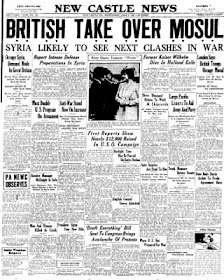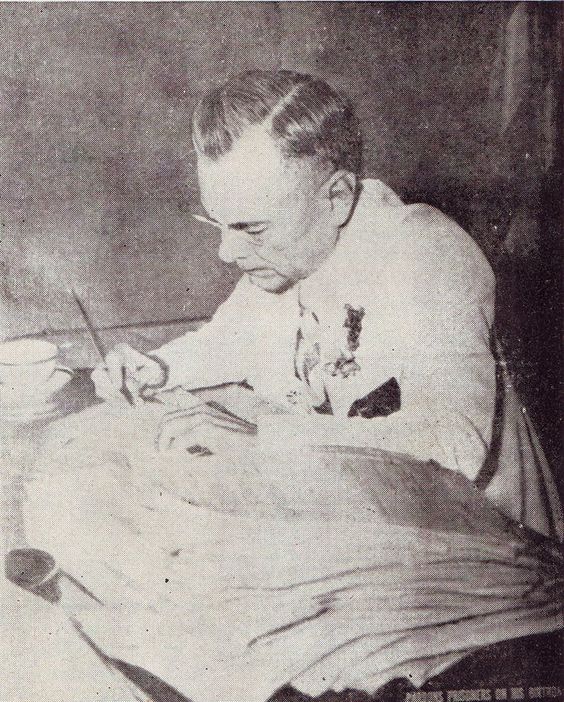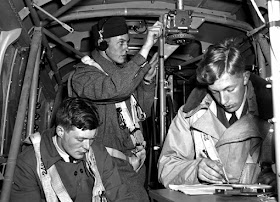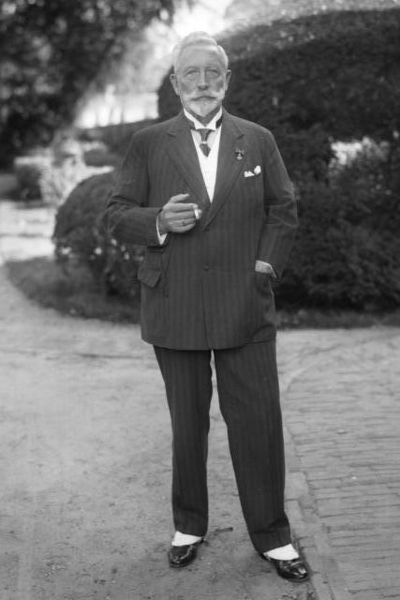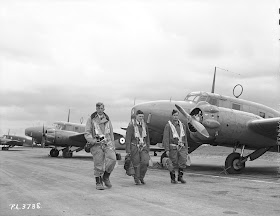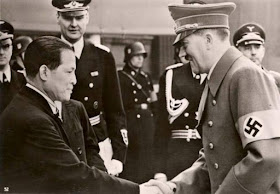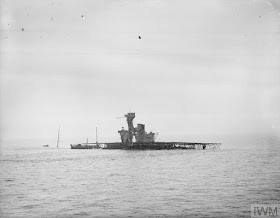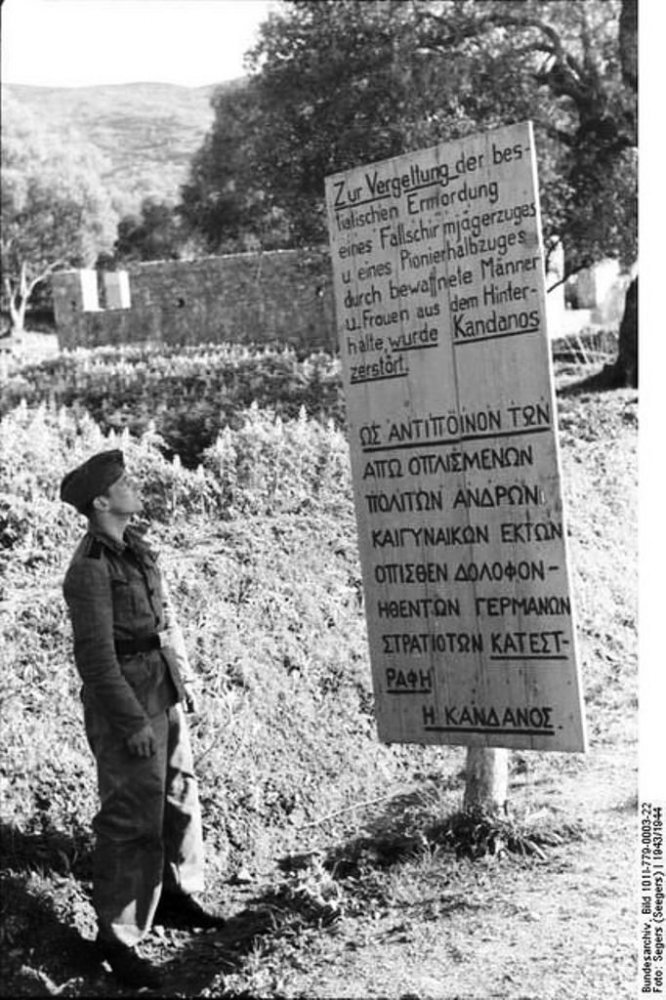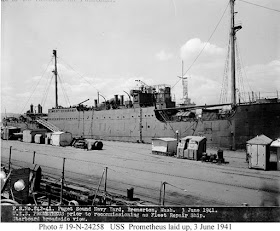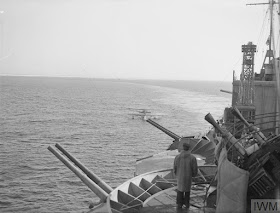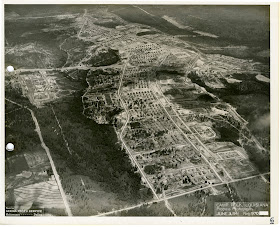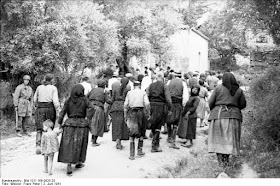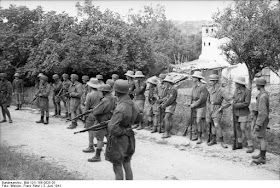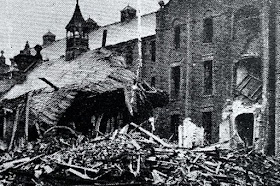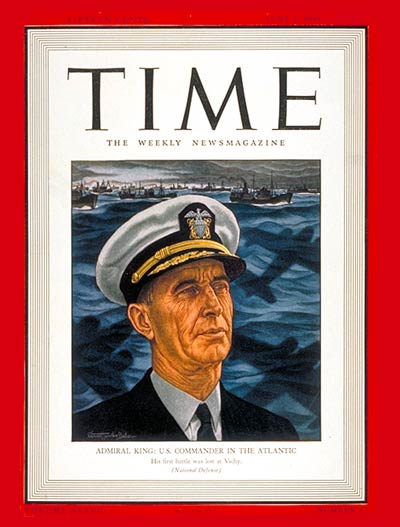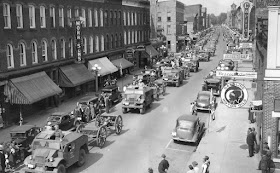Sunday 1 June 1941
 |
| Farhud Riot, Baghdad, 1 June 1941. |
Anglo/Iraq War: Prince 'Abd al-Ilah (Abdullah), who has been waiting patiently at the British airbase at Habbaniya, returns to Baghdad as the Regent on 1 June 1941. The pro-British monarchy and government are put back in place. British troops, by and large, remain outside Baghdad because they are vastly outnumbered by Iraqi troops and the city's populace.
There now begins two days of violence in Baghdad that occur during the Jewish holiday of Shavuot. This is known as the Farhud (pogrom, literally "violent dispossession") and is directed against the Jewish Quarter. The incident begins (this is disputed) when a delegation of Jewish Iraqis leaves their homes to journey to the Palace of Flowers (Qasr al Zuhur) to pay their respects to the newly returned regent. An Arabic mob attacks them as they cross Al Khurr Bridge. The riot builds in intensity throughout the day.
This begins a long process and persecution that virtually eliminates historic communities of Sephardic Jews from the Arab world. This incident is sometimes referred to as the "forgotten pogrom." It apparently is a spontaneous reaction to the British defeat of the Rashid Ali government, because Jews have lived in Iraq for hundreds and hundreds - 1200 - years.
Everything about the Farhud is disputed, including what actually happens during it and its long-term effect. It is estimated that 130-180 Jews - maybe hundreds more - are killed during the Farhud pogrom. There also are 1000 injured. Many non-Jews also are killed, some when they attempt to intervene to protect Jews. Some 900 Jewish homes are destroyed and there is widespread looting of Jewish property. Some call this part of the Holocaust, others define it as a separate event.
 |
| Another view of the Farhud pogrom in Baghdad, 1 June 1941. |
European Air Operations: In order to cover up the movement of the mass of its planes to the East, the Luftwaffe raids Great Britain with 110 aircraft. The main target is Manchester. Another force of about 130 planes bombs Merseyside (Liverpool).
The Luftwaffe begins making command appointments preparatory to Operation Barbarossa. Oblt. Wilfried Balfanz becomes Gruppenkommandeur of I / JG 53. Major Joachim Seegert is made Gruppenkommandeur of I./JG 77.
Premier fighter squadron JG 26 (Adolf Galland) moves to new bases. I group to Clairmarais near St. Omer, II Gruppe to Maldegem in Belgium and III Gruppe to Ligescourt (Liegescourt) north of Abbeville. While elements of JG 26 fight at various times in the Mediterranean and the Soviet Union, most of the formation remains on the Channel Front throughout the war.
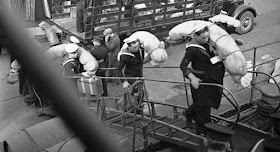 |
| British sailors bring their kits aboard a Lend-Lease vessel, ready to sail her across the Atlantic, on June 1, 1941 (AP Photo)/ |
Battle of the Atlantic: U-105 (Kapitänleutnant Georg Schewe), on its extended second patrol out of Lorient and operating off Freetown, Sierra Leone, torpedoes and sinks 4719-ton British collier Scottish Monarch southwest of the Cape Verde Islands. There is one death and 44 survivors rescued by Dutch freighter Alphard and British freighter Christine Marie.
U-107 (K.Kapt. Günther Hessler), on its second patrol and operating 140 miles off Sierra Leone, Freetown, torpedoes and sinks 5013-ton British freighter Alfred Jones. Alfred Jones is part of Convoy OB 320 and, among other things, carries RAF planes bound for Gambia (and thence Egypt). There are two deaths, the 62 survivors are picked up by corvette HMS Marguerite.
U-204 (Kptlt. Walter Kell), operating northwest of Dyrafjord, Iceland, is on its first patrol and en route to Wolfpack West when it spots a fishing trawler. Kell surfaces and uses his deck gun to sink 16-ton Icelandic trawler Holmsteinn. Some sources place this on 31 May.
Italian submarine Marconi uses its deck gun to sink 318-ton Portuguese fishing trawler Exportador I about 137 miles southwest of Cape St. Vincent. There are two deaths, twenty crew are rescued.
The Luftwaffe bombs and damages 4333-ton Norwegian freighter Fernbank off Peterhead, Scotland. The ship makes it into Aberdeen before the end of the day.
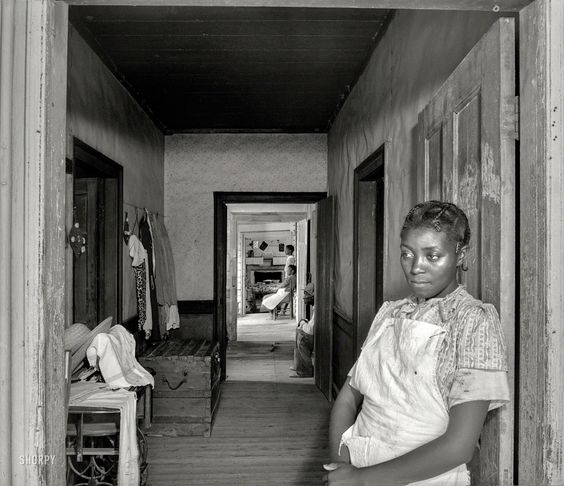 |
| June 1941. "Interior of Negro rural house. Greene County, Georgia." Negative by Jack Delano, Farm Security Administration (Shorpy). |
Prinz Eugen sails into the French port of Brest unnoticed by the Royal Navy. Prinz Eugen has engine trouble that requires extensive repairs, and it will spend the rest of 1941 being repaired. This concludes Operation Rheinübung, a failure by the Kriegsmarine.
Prinz Eugen joins idle battlecruisers Scharnhorst and Gneisenau in the port. They all sit idle in the port with no plans for use, which likely would have been the fate of battleship Bismarck as well had it survived. German warships no longer will challenge Royal Navy supremacy on the high seas, though there will still be occasional deadly encounters. The U-boat fleet, however, remains as deadly as ever and is increasing in size and range.
The Royal Navy now begins a concerted effort to find and eliminate the Kriegsmarine's highly effective overseas supply network. These "milch" ships have been supplying both German surface raiders and the U-boat fleet. The German supply ships typically sail under false flags, but their true defense is simply operating in areas outside the shipping lanes and depending upon the vastness of the Atlantic to hide them.
The US Coast Guard establishes the South Greenland Patrol under Commander Harold G. Belford, USCG. This consists of Coast Guard cutters USCGC Modoc (CGC-39) and USCGC Comanche (CGC-57); yard tug USCGC Raritan (CGC-72); and the U.S. Navy's unclassified auxiliary vessel USS Bowdoin (IX-50), a schooner. Their patrol line is Cape Brewster in the northeast to Cape Farewell to Upernivik Island on the northwest coast.
RAF No. 120 Squadron forms at Nutts Corner, Northern Ireland. It uses American-built Consolidated Liberator long-range maritime patrol aircraft. There remains a large mid-ocean gap where aerial reconnaissance remains impossible at this time, but this covers of the Northwest Approaches makes that area much safer for Allied ships.
Royal Navy minelayer HMS Teviotbank lays minefield BS.63 in the English Channel.
Convoy HX 130 departs from Halifax with a heavy escort including battleship HMS Ramillies, Convoy SC 33 departs Sidney, BC.
 |
| "Female members of the First Aid Nursing Yeomanry (FANY) unit attached to the 1st Polish Corps (commanded by Diana Napier) doing maintenance work on their ambulance at Cupar, 1 June 1941." © IWM (H 10164). |
Battle of the Mediterranean: On Crete, 3710 British troops and others are taken off by the Royal Navy during the night of 31 May/1 June. After that, evacuations end. A total of about 16,511 people out of the starting force of 32,000 make it off the island to safety in Egypt.
During the day, the Luftwaffe (Junkers Ju 88) hits retreating cruiser HMS Calcutta with two bombs. The cruiser sinks within minutes about 100 miles northwest of Alexandria. There are 255 survivors and 118 perish.
During the day, the embarkation port of Sfakia falls to the Wehrmacht. About 5000 Commonwealth troops (Australian Lieutenant Colonel Theo Walker) defending Sfakia surrender and immediately go into captivity. It is estimated that about 12,000 British and Dominion troops and uncounted thousands of Greek troops remain on the island. Some of them surrender now, some of them surrender later at some point during 1941, some of them go into hiding in the numerous caves on the island and work with partisans, and some still attempt to somehow make it to Egypt, with little success.
The remnants of Layforce, Australian 19th Infantry Brigade, and Brigadier Vasey all surrender. A large group of Commonwealth troops that defended Retimo (Rethymno) also surrenders.
The British Air Ministry announces:
After twelve days of the bitterest fighting of the war so far, it has been decided to withdraw our forces from Crete. Although the enemy has suffered massive losses of men and material, we would not in the long term have been able to continue successful troop operations on the island without substantial support from the aerial and naval forces.
The battle for Crete is over: German Operation Mercury has been a resounding success. That the Germans have scored an impressive victory using a new kind of warfare - airborne troops - is undeniable. However, in achieving the victory, the Germans have taken a lot of casualties (as have the British). The numbers lost on both sides have been studied endlessly, and all of the results have methodological assumptions that call into question how accurately they reflect the fighting on Crete during May 1941. Let's go through this briefly.
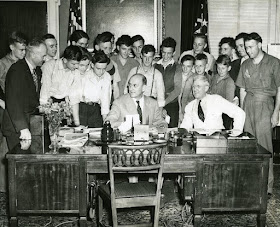 |
| U.S. Secretary of the Treasury Henry Morgenthau Jr. sits with schoolchildren in his office at the Treasury Building in Washington, D.C. June 1, 1941. (The Franklin D. Roosevelt Presidential Library and Museum). |
The tendency is to overestimate the number of German troops lost during Operation Mercury. Winston Churchill claims that the Germans have lost over 15,000 casualties, while Admiral Andrew Cunningham pegs the figure well above there. Over Allied assessments place the figure in that general vicinity. The United States Army Center of Military History places the number of German casualties around 6,000-7,000 men.
The actual number almost certainly is far lower than the amounts claimed by the Allies. Figures as low as 1,990 Germans killed, 2,131 wounded, and 1,995 missing for a total of 6,116 total casualties have been thrown out. Generally, German sources place the figure far lower. Daniel Marcus Davin, in his "The Official History of New Zealand in the Second World War, but the figures at 2,124 Germans killed and 1,917 missing men, totaling 4,041 killed and missing. Add to that 2,640 wounded and 17 Germans captured and you come up with 6,698 total German casualties during Operation Mercury - some of whom could be healed and returned to action. So, realistically the Germans lost roughly 5,500 soldiers to death and incapacitating wounds in taking Crete, but any number you use is subject to attack.
British losses are vastly higher than the German losses. The British began the Crete battle with about 32,000 men. Their losses on Crete are listed as 1,742 killed, 1,737 wounded, and 11,835 taken prisoner. British Major General I.S.O. Playfair and his colleagues in 1956 come up with 3,579 British Commonwealth men killed and missing (presumed to be the same thing), with an additional 1,918 wounded and 12, 254 captured for 17,754 total British permanent losses on land.
However, to those British land losses must be added 1,828 Royal Navy crewmen killed and 183 wounded. In addition, 5,255 of 10,000 Greek refugees from the mainland are listed as captured. In addition, thousands of civilians are lost during the battle, partly due to bombing, but also partly due to the fact that many take up guns and try to defend their own villages. The best figures on Cretan deaths during Operation Mercury are 6,593 men, 1,113 women, and 869 children. The Cretan civilian casualties, however, are just beginning, so it is difficult to attribute some to Operation Mercury and others to post-battle German reprisals.
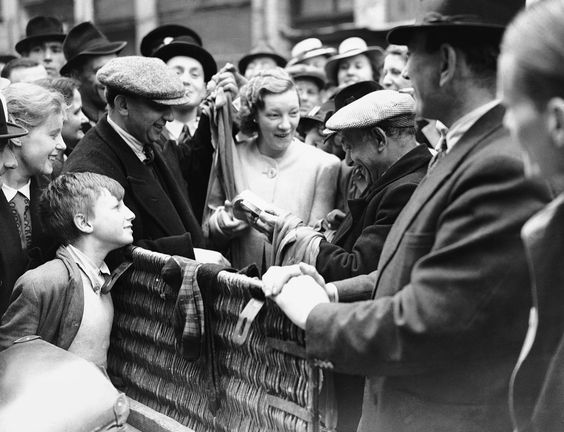 |
| "A woman makes a purchase of silk stockings at a stall in London’s famous Petticoat Lane on June 1, 1941" Stockings now are rationed, along with other clothing - but not used clothes, which can be bought without rations coupons (AP Photo). |
The Royal Navy has lost cruisers HMS Calcutta, Fiji and Gloucester and destroyers Greyhound, Hereward, Juno Kashmir, and Kelly. It also has incurred serious damage to aircraft carrier Formidable, battleships Barham and Warspite, cruisers Ajax, Dido, and Perth, submarine Rover, and destroyers Kelvin and Nubian. Heavy cruiser York, beached on 26 March and used thereafter as a gun platform, now is a total write-off.
The Luftwaffe certainly has taken losses, as the British claim 22 aircraft definitely destroyed, 11 probably destroyed, and 21 damaged. However, the Luftwaffe has thousands of planes available. In the broadest sense, the battle between the Luftwaffe and the Royal Navy - the RAF barely intervened in the battles off Crete - has proven decisively that airpower is superior to naval power. Big ships cannot operate when the skies are dominated by the enemy.
In sum, the battle for Crete has been a complete disaster for the Royal Navy and the British Commonwealth in general. Its strength is now reduced to two battleships and three cruisers. The Italian Navy in the Mediterranean now outnumbers it with four battleships and eleven cruisers, but the Italians don't use their big ships very often, preferring to maintain them as a "fleet in being."
Operation Mercury also proves something more troubling to the British: simply knowing in advance what the Germans are going to do doesn't mean they can be stopped. It is certain that the British government knows before the first airborne troops land on Crete that it is going to be invaded, and how. This, however, does not prevent the German victory - though it likely contributed to the size of Wehrmacht casualties. When Adolf Hitler decides to no longer use airborne troops in offensive operations, it is a wise decision because the British Ultra decrypts enable the British to kill the descending German soldiers at their most vulnerable points and isolate those that survive. Hitler doesn't know about Ultra - but his decision to shelve future projects such as an airborne invasion of Malta probably avoids some disasters due to Ultra.
The war on Crete is not over - in some respects it is just beginning. The Germans already have standing orders from temporary island commander Luftwaffe General Kurt Student to enact reprisals against Greek civilians. Crete is a hugely valuable German defensive bulwark against British attacks on southeastern Europe, but otherwise, it is a relatively useless victory that brings little profit.
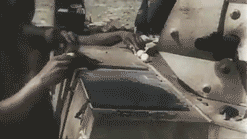 |
| Some Afrikakorps boys have some fun cooking eggs on their Panzer II tank, mid-1941. |
The British begin reorganizing their RAF command in the Middle East. Arthur William Tedder, 1st Baron Tedder is appointed Air Officer Commanding in Chief, RAF Middle East Command. Previously, he has been Air Officer Commanding in Chief, RAF Middle East Command. He retains his temporary rank (since 29 November 1940) of air marshal. Winston Churchill previously, in December 1940, sent Air Vice-Marshal Owen Tudor Boyd to take over the position, but Boyd's plane crash-landed on Sicily and he was taken as a prisoner. Marshal Tedder commands the RAF in its continuing operations over North Africa and the eastern Mediterranean.
Air Vice-Marshal Hugh Lloyd becomes Air Officer Commanding Malta, replacing Air Commodore F. H. M. Maynard. Lloyd previously was Senior Air Staff Officer at RAF No 2 (Bombing) Group Abingdon in England. His mission is to bomb Axis convoys between Naples and Tripoli.
Royal Navy submarine HMS Clyde torpedoes and sinks 3076-ton Italian freighter San Marco about five miles off Capo Carbonara, southeast of Sardinia. The Clyde misses with a torpedo fired at another ship.
Royal Navy submarine HMS Torbay uses its deck gun to sink a caique carrying Wehrmacht troops in the Doro Channel (east of Athens).
The Royal Navy sends 758-ton tanker Balmaha from Alexandria to supply the garrison at Tobruk. It is a hazardous journey that will take days, and the tanker has escorts of sloop Auckland and trawler Southern Maid.
An Axis convoy leaves Naples bound for Tripoli with a heavy escort that includes two cruisers and six destroyers.
Royal Navy aircraft carrier HMS Furious arrives at Gibraltar carrying 48 Hawker Hurricane Mk II planes. It transfers 24 to fellow carrier Ark Royal and sends 4 ashore. Taking aboard the aircraft from aircraft carrier Argus, Furious then prepares to lead another supply mission to Malta, Operation Rocket.
 |
| The Shadow magazine, 1 June 1941. "The Shadow knows!" |
Spy Stuff: Soviet sleeper spy Richard Sorge makes another covert wireless transmission to Moscow. He tells them that German Lt. Colonel Edwin Scholl has told him that the Germans have massed 170-190 divisions along the Soviet border and plan to invade on 15 June. In Moscow, Stalin is tired of reading these endless warnings. The transmission is marked "suspicious" and "provocative." If Sorge were to return to Moscow at this time, he likely would be cashiered and perhaps imprisoned. However, the staff in the Kremlin maintains a record of the warnings for possible future use.
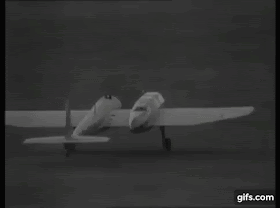 |
| A Blohm & Voss BV 141. The engine is on the left fuselage, the right fuselage is just a gondola for the observer. |
German Military: First flight of the Blohm & Voss BV 141 tactical reconnaissance aircraft. Its distinctive design includes a separate, engine-less fuselage that serves as an observation gondola. A total of 20 will be built, but the Luftwaffe prioritizes other planes that use engines that are more readily available.
US Military: The United States military commissions a naval and air base at Chaguaramas, Trinidad. This has been in the works since the USS St. Louis brought a party of workers to the site on 10 October 1940. It is not yet at full operation (that doesn't happen until 1943). British Governor Young of Trinidad is unhappy - he does not like that the US base displaces locals and closes the nearby beaches. Authority is pursuant to the Lease Land Agreement, the Defence Regulations, and the Trinidad Base Agreement. This base will remain open (as Waller Air Force Base) until 1949, with some Americans remaining there until 1977.
Camp located is completed in Hitchcock, Texas (located at the present site of Jack Brooks Park in Hitchcock). It is an Army Basic Training Camp that ultimately includes 399 buildings and is operational from 1941 to 1946.
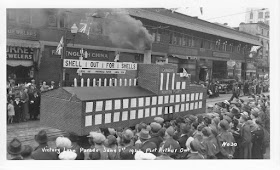 |
| "A view of the Canadian Munition Plants float with the slogan, "Shell out for Shells" in the Victory Loan Parade, June 1, 1941, Port Arthur, Ontario." (Thunder Bay Public Library, Gateway to Northwestern Ontario History). |
Channel Islands: Major General Erich Muller relieves Rudolf von Schmettow as military governor of the Channel Islands. Von Schmettow, however, remains in command of Jersey. During the month, Infantry Division 319 relieves ID 216 on the islands.
China: A Japanese air raid destroys four Chinese Soviet SBs of the 12th BG at Zhaotung.
Vatican: Pope Pius XII makes a
radio broadcast in celebration of the feast of Pentecost. The speech is entitled "The Individual Right Cannot in Any Way Be Suppressed." The Pope only obliquely references the war, noting that he is making the speech at a time that "pregnant with events that are known only to the divine counsels which rule the story of nations and watch over the church," a statement that can be interpreted as implying that, being behind Axis lines, the Church cannot speak out more about the war. He does make occasional veiled references to "the growing paganism of public life" and emphasizes the importance of respect for private property.
 |
| "Diana Napier, a section commander of the First Aid Nursing Yeomanry (FANY) unit attached to the 1st Polish Corps, at the wheel of one of her section's ambulances in conversation with a Polish Army Major at Cupar, 1 June 1941. The unit was presented with 62 ambulances from the USA in the last 10 months. Mrs. Napier was a creator of this medical unit and a first ambulance was a gift from her." © IWM (H 10146). Diana "Mollie" Napier, incidentally, was at the time a well-known English film actress. She joined the First Aid Nursing Yeomanry in April 1940. |
German Homefront: The German government bans all Catholic publications in the Reich.
British Homefront: Minister of Food Lord Woolton begins rationing of clothing. It is based on a points (coupon) system. Every person is allotted 66 points per year, and different articles of clothing have their own points: 16 points for a woman's raincoat (mackintosh), a woman's petticoat 4 points, 2 points for a pair of stockings (if you can find them), and so on. The point values for men are 13 points for a jacket, 8 for pants, 7 for shoes, 5 for a waistcoat, socks 3 points. Coupons can be passed around within families. The good news is that used clothing is not rationed, only new clothing. Women flock to Petticoat Lane today to buy stockings.
American Homefront: Archbishop Fulton J. Sheen delivers a
speech at the commencement of Notre Dame University in South Bend, Indiana. He tags "the decline of patriotism in America" to "a decline of religion" which causes people to "cease to love their neighbor." The speech is pro-intervention in Europe, with Sheen noting:
And if there are certain things that are not worth fighting for, there are some things that are; above all else, that one thing is the foundation of our rights and liberties.
More pointedly, he concludes:
Democracy has within itself no inherent guarantee of freedom; these guarantees are from without. That is why I say our Declaration of Dependence on God is the condition of a Declaration of Independence of Dictatorship.
Sheen equates being religious with defeating what he views as anti-religious impulses in the world, which can only mean the Axis.
In Chicago, Jenny Dolly of The Dolly Sisters, a popular Hungarian twins act of the 1920s, hangs herself after years of depression. She is buried in Forest Lawn Memorial Park, Glendale, California.
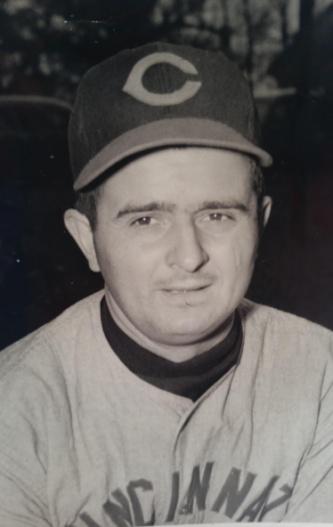 |
| Chuck Aleno of the Cincinnati Reds. |
Cincinnati Reds third baseman Chuck Aleno goes hitless in New York. This ends his 17-game hitting streak, which set a Major League record because they were the first 17 games of Aleno's Major League career. The record is tied in 2016 by Colorado Rockies left fielder David Dahl, but it never has been broken. In the same game, Mel Ott of the New York Giants hits his 400th career home run and gets his 1500th RBI at the Polo Grounds in a 3-2 Giants win.
In Cleveland, Joe DiMaggio extends his current hitting streak to 18 games by getting hits in both ends of a twin-bill that results from a rained-out game on Saturday.
Future History: Wilmer Dean Chance is born in Wooster, Ohio. He becomes a Major League Baseball pitcher and wins the 1964 Cy Young Award, the youngest at the time to win the award. He also will begin the International Boxing Association during the 1990s. Dean Chance passes away on October 11, 2015.
The Farhud pogrom will be virtually forgotten until the 21st Century. Then, beginning around 2005, some books will mention it. The United Nations designates June 1, 2015, as International Farhud Day.
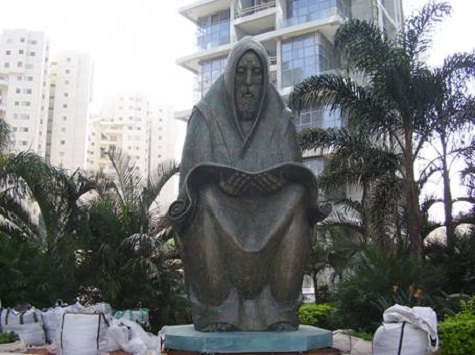 |
| Farhud Memorial in Ramat Gan, Baghdad. |
May 1941
May 1, 1941: British Hold Tobruk
May 2, 1941: Anglo-Iraq War
May 3, 1941: Liverpool Hammered
May 4, 1941: Hitler Victory Speech
May 5, 1941: Patriots Day
May 6, 1941: Stalin In Command
May 7, 1941: May Blitz
May 8, 1941: Pinguin Sunk
May 9, 1941: U-110 Captured
May 10, 1941: Hess Flies Into History
May 11, 1941: The Hess Peace Plan
May 12, 1941: Tiger Arrives Safely
May 13, 1941: Keitel's Illegal Order
May 14, 1941: Holocaust in Paris
May 15, 1941: Operation Brevity
May 16, 1941: Blitz Ends
May 17, 1941: Habbaniya Relieved
May 18, 1941: Croatia Partitioned
May 19, 1941: Bismarck at Sea
May 20, 1941: Invasion of Crete
May 21, 1941: Robin Moore Sinking
May 22, 1941: Royal Navy Destruction Off Crete
May 23, 1941: Crete Must Be Won
May 24, 1941: Bismarck Sinks Hood
May 25, 1941: Lütjens' Brilliant Maneuver
May 26, 1941: Bismarck Stopped
May 27, 1941: Bismarck Sunk
May 28, 1941: Crete Lost
May 29, 1941: Royal Navy Mauled Off Crete
May 30, 1941: Sorge Warns, Stalin Ignores
May 31, 1941: British Take Baghdad
June 1941
June 1, 1941: Farhud Pogrom
June 2, 1941: Massacres on Crete
June 3, 1941: Kandanos Massacre
June 4, 1941: Kaiser Wilhelm Passes Away
June 5, 1941: Death in Chungking
June 6, 1941: Hitler's Commissar Order
June 7, 1941: Commandos Strike at Pessac
June 8, 1941: British Invade Syria and Lebanon
June 9, 1941: Litani River Battle
June 10, 1941: British Take Assab
June 11, 1941: Hitler Thinking Beyond Russia
June 12, 1941: St. James Agreement
June 13, 1941: Lützow Damaged
June 14, 1941: Latvian June Deportations
June 15, 1941: Operation Battleaxe
June 16, 1941: The Old Lion
June 17, 1941: British Spanked in North Africa
June 18, 1941: Turkey Turns Its Back
June 19, 1941: Cheerios Introduced
June 20, 1941: Birth of US Army Air Force
June 21, 1941: Damascus Falls
June 22, 1941: Germany Invades Russia
June 23, 1941: A Soviet KV Tank Causes Havoc
June 24, 1941: Kaunas and Vilnius Fall
June 25, 1941: Finland Declares War
June 26, 1941: Bombing of Kassa
June 27, 1941: Encirclement At Minsk
June 28, 1941: Minsk Falls
June 29, 1941: Brest Fortress Falls
June 30, 1941: Mölders Becomes Top Ace
2020

